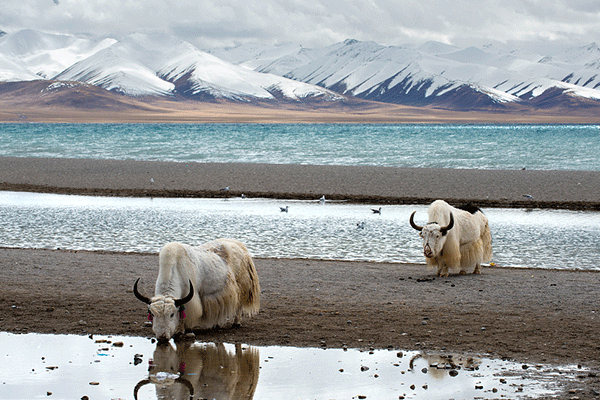Invest in Tibet
Overview
The Tibet autonomous region, with its capital in Lhasa, is one of the five autonomous regions of ethnic groups in China.
The Tibet autonomous region is located in the southwestern part of China's Qinghai-Tibet Plateau. It covers an area of over 1.2 million square kilometers. The area over 4,000 meters above sea level accounts for 85.1 percent of the total area of the region, which is known as the "roof of the world" and "the third pole of the earth".
Tibetan people have their own language and characters. The Tibetan language belongs to the Tibetan branch of the Tibeto-Burman language of the Sino-Tibetan language family. It is divided into three dialects, namely, Tibetan, Kham, and Amdo. The word "Tibetan characters" is written "bod-yig". As a written communication tool for the Tibetan people, the Tibetan characters have a long history that is second only to Chinese characters in China.
With a population of more than 3 million, the Tibet autonomous region has the smallest population of such regions in China, but Tibetan people account for 94.7 percent of the region's total population.
Tibet is a place which enjoys enriched light resources, wind resources, water resources, grassland farmland resources, forest resources, plant resources, animal resources, wetland resources, and mineral resources.

[Photo/VCG]
The GDP of the Tibet autonomous region in 2018 was 147.76 billion yuan ($20.57 billion), an increase of 9.1 percent over 2017. Primary industry grew by 3.4 percent or 13.03 billion yuan, secondary industry grew by 17.5 percent or 62.84 billion yuan, and tertiary industry grew by 4.1 percent or 71.90 billion yuan.
Pillar Industries

[Photo/VCG]
Agriculture and animal husbandry
The Tibetan economy is dominated by subsistence agriculture. Due to limited arable land, the primary occupation of the Tibetan Plateau is raising livestock, such as sheep, cattle, goats, camels, and horses.
During the 12th Five-year Plan period (2011-2015), the government invested 78.72 billion yuan in supporting agriculture, significantly strengthening the basic position of agriculture and animal husbandry. A total of 1.37 million mu of high standard farmland was built, 152,000 sheds of livestock were added in alpine pastoral areas, and grain output exceeded 1 million tons. In 2015, the gross output value of leading agricultural and animal husbandry enterprises in the autonomous region increased by 62.3 percent, and the operating rate of agricultural and animal husbandry industrialization reached 40 percent.
Characteristic advantageous industries
The region is vigorously cultivating and developing many characteristic industries such as plateau crop planting and harvesting, clean energy, natural drinking water, Tibetan medicine, tourism, and national handicrafts. In 2015, the added value of primary industries in the region was 9.69 billion yuan, an annual increase of 3.9 percent, while the added value of secondary industries was 37.62 billion yuan, a growth of 15.7 percent, and the added value of tertiary industries was 55.33 billion yuan, up 8.9 percent. The overall scale of the tertiary industry exceeded that of the first and second industries taken together.
Advantages
Government support
The government focuses on the implementation of the rural and herdsman housing project. A cumulative investment of 27.8 billion yuan has been used for the project for eight consecutive years through integrating central subsidy funds, financial funds, social funds, and private funds.
The government takes vigorous measures to construct basic infrastructure including water, electricity, roads, and communication networks. It also strongly pursues better postal services, radio and television, farmer's bookshops, and beautiful environments for the Tibetan people’ s benefit.
Enriched resources
Light resources. The annual total solar radiation in Tibet reaches 140-200 kcal / sq cm, nearly two times that of the eastern coastal areas of China.
Wind resources. Tibet is one of the windiest regions in China (≥8 or 17 m/s). The average annual number of windy days is as many as 100-150, and can rise to 200 days, 4 to 30 times more than the eastern part of China at the same latitude.
Water resources. The total amount of water resources in the region is 439.47 billion cubic meters (excluding groundwater), or 16.21 percent of the total river runoff volume in China. The per capita water resources occupancy and the average water occupancy per mu (0.067 hectares) are the highest in the country.
Grassland farmland resources. The region has 1.33 billion mu (88.9 million hectares) of natural grassland, accounting for 74.11 percent of the region’ s, the largest such area in the country, of which 1.13 billion mu are available. It also has 6,626,600 mu of arable land (the substantially controlled area is 5,550,750 mu), of which 0.62 million mu are paddy fields, 3.98 million mu are irrigated land, and 2.02 million mu are dry land.
Forest resources. The area has 17.84 million hectares of forest land, and 1,475,600 hectares of forest area. The per capita forest area is 49,000 square meters, ranking first in the country. Its forest coverage rate is 11.98 percent, the country’s fifth largest.
Animal resources. The number of large and medium-sized wild animals in the whole region is the highest in China. The population of Tibetan antelope is more than 80 percent of the world’s, 80 percent of the world’s black-necked cranes overwinter in Tibet, and the area’s volume of wild cattle consumption is 78 percent of the world’s.
Wetland resources. Tibet has 6.53 million hectares of wetlands, 5.3 percent of its total area, and the second largest wetland area in China.
Mineral resources. To date, one hundred and three mineral types (subtypes) and more than 3,000 mineral deposits, points and mineralization sites have been found in Tibet, and reserves of 49 kinds of minerals have been identified. The dominant mineral resources found in the region include copper, chromium, lead, zinc and silver polymetallic, molybdenum, iron, antimony, gold, and natural mineral water, all with broad prospecting potential.
Investment promotion agencies
1. The People's Government of Tibet Autonomous Region
Contact:
Address: No 1-2 Kang’ang East Road, Chengguan District, Lhasa
Postcode: 850000
2. Department of Commerce of Tibet Autonomous Region
Contact:
Tel: 0891-6861191
E-mail: admin@xzswt.gov.cn
Address: No 56 JinzhuWest Road, Lhasa
Postcode: 850000
3. Nyingchi Commerce Bureau
Contact:
Tel: 0894-5828770 、0894-5823893
Fax: 0894-5823893
E-mail: lzswjxxzx@163.com
Postcode: 860000
Invest in China Copyright © 2024 China Daily All rights Reserved
京ICP备13028878号-6
 京公网安备 11010502032503号
京公网安备 11010502032503号





